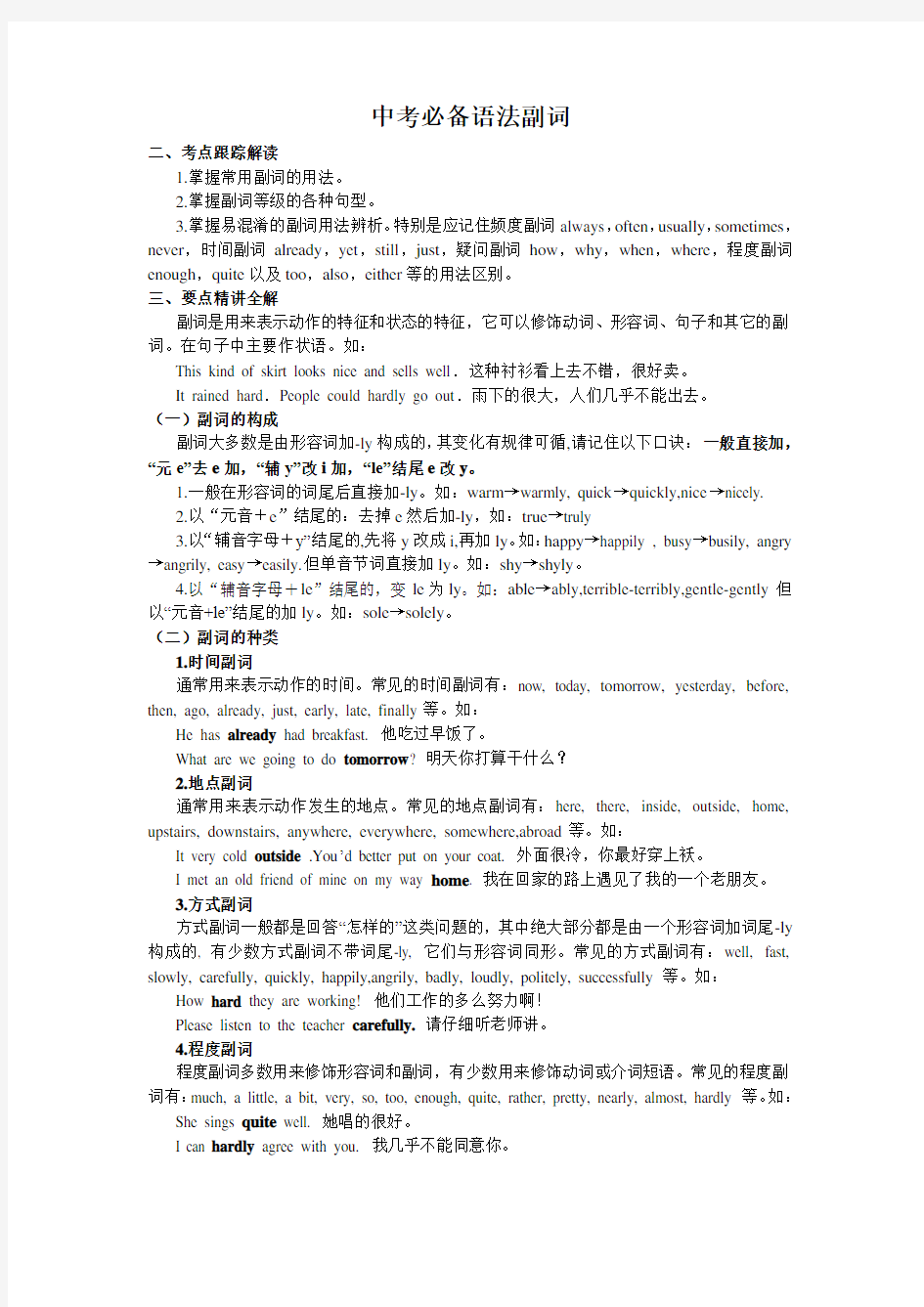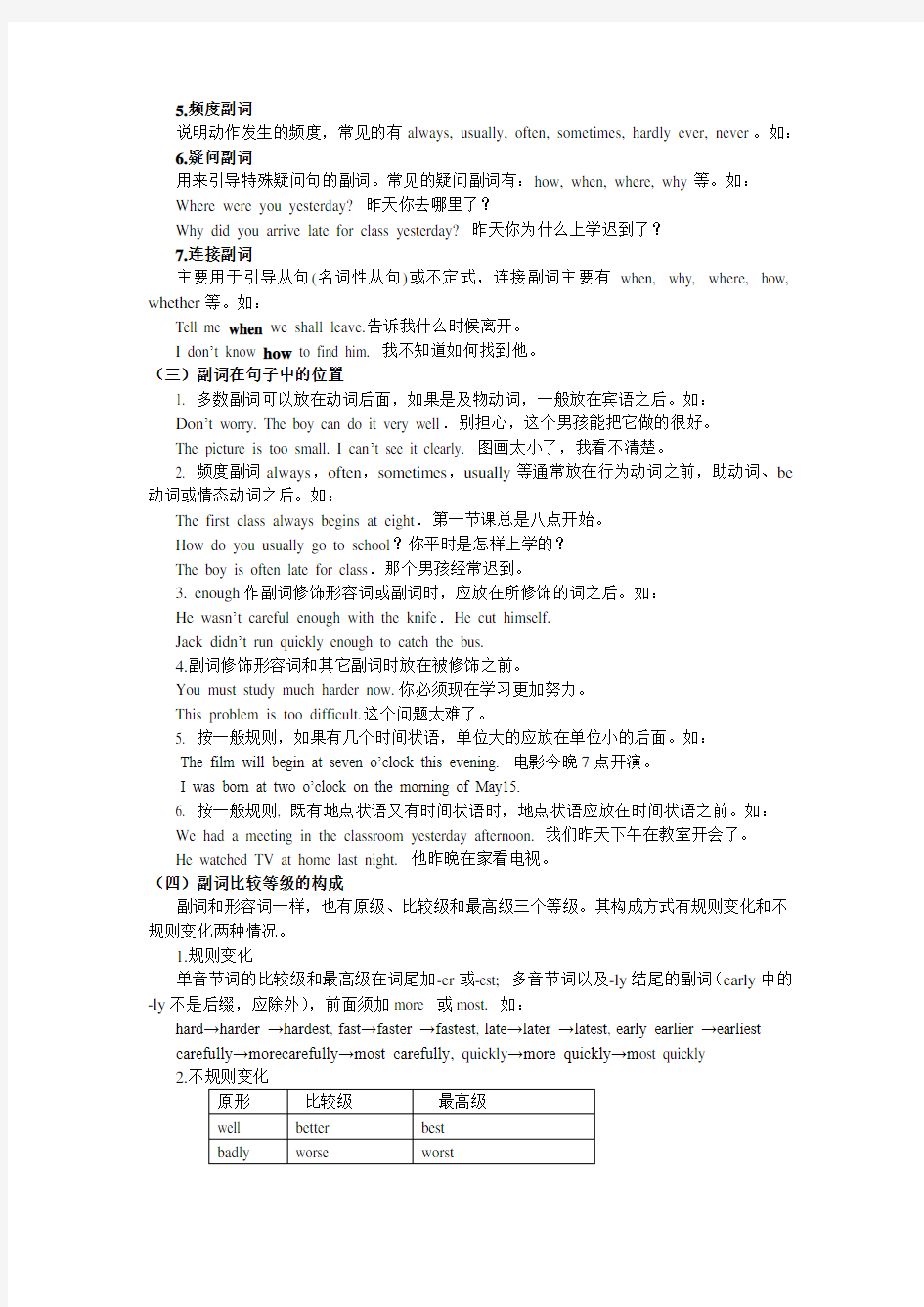中考必备语法 副词


中考必备语法副词
二、考点跟踪解读
1.掌握常用副词的用法。
2.掌握副词等级的各种句型。
3.掌握易混淆的副词用法辨析。特别是应记住频度副词always,often,usually,sometimes,never,时间副词already,yet,still,just,疑问副词how,why,when,where,程度副词enough,quite以及too,also,either等的用法区别。
三、要点精讲全解
副词是用来表示动作的特征和状态的特征,它可以修饰动词、形容词、句子和其它的副词。在句子中主要作状语。如:
This kind of skirt looks nice and sells well.这种衬衫看上去不错,很好卖。
It rained hard.People could hardly go out.雨下的很大,人们几乎不能出去。
(一)副词的构成
副词大多数是由形容词加-ly构成的,其变化有规律可循,请记住以下口诀:一般直接加,“元e”去e加,“辅y”改i加,“le”结尾e改y。
1.一般在形容词的词尾后直接加-ly。如:warm→warmly, quick→quickly,nice→nicely.
2.以“元音+e”结尾的:去掉e然后加-ly,如:true→truly
3.以“辅音字母+y”结尾的,先将y改成i,再加ly。如:happy→happily , busy→busily, angry →angrily, easy→easily.但单音节词直接加ly。如:shy→shyly。
4.以“辅音字母+le”结尾的,变le为ly。如:able→ably,terrible-terribly,gentle-gently但以“元音+le”结尾的加ly。如:sole→solely。
(二)副词的种类
1.时间副词
通常用来表示动作的时间。常见的时间副词有:now, today, tomorrow, yesterday, before, then, ago, already, just, early, late, finally等。如:
He has already had breakfast. 他吃过早饭了。
What are we going to do tomorrow? 明天你打算干什么?
2.地点副词
通常用来表示动作发生的地点。常见的地点副词有:here, there, inside, outside, home, upstairs, downstairs, anywhere, everywhere, somewhere,abroad等。如:
It very cold outside .You’d better put on your coat. 外面很冷,你最好穿上袄。
I met an old friend of mine on my way home. 我在回家的路上遇见了我的一个老朋友。
3.方式副词
方式副词一般都是回答“怎样的”这类问题的,其中绝大部分都是由一个形容词加词尾-ly 构成的, 有少数方式副词不带词尾-ly, 它们与形容词同形。常见的方式副词有:well, fast, slowly, carefully, quickly, happily,angrily, badly, loudly, politely, successfully等。如:How hard they are working! 他们工作的多么努力啊!
Please listen to the teacher carefully.请仔细听老师讲。
4.程度副词
程度副词多数用来修饰形容词和副词,有少数用来修饰动词或介词短语。常见的程度副词有:much, a little, a bit, very, so, too, enough, quite, rather, pretty, nearly, almost, hardly等。如:She sings quite well. 她唱的很好。
I can hardly agree with you. 我几乎不能同意你。
5.频度副词
说明动作发生的频度,常见的有always, usually, often, sometimes, hardly ever, never。如:
6.疑问副词
用来引导特殊疑问句的副词。常见的疑问副词有:how, when, where, why等。如:
Where were you yesterday? 昨天你去哪里了?
Why did you arrive late for class yesterday? 昨天你为什么上学迟到了?
7.连接副词
主要用于引导从句(名词性从句)或不定式,连接副词主要有when, why, where, how, whether等。如:
Tell me when we shall leave.告诉我什么时候离开。
I don’t know how to find him. 我不知道如何找到他。
(三)副词在句子中的位置
1. 多数副词可以放在动词后面,如果是及物动词,一般放在宾语之后。如:
Don’t worry. The boy can do it very well.别担心,这个男孩能把它做的很好。
The picture is too small. I can’t see it clearly. 图画太小了,我看不清楚。
2. 频度副词always,often,sometimes,usually等通常放在行为动词之前,助动词、be 动词或情态动词之后。如:
The first class always begins at eight.第一节课总是八点开始。
How do you usually go to school?你平时是怎样上学的?
The boy is often late for class.那个男孩经常迟到。
3. enough作副词修饰形容词或副词时,应放在所修饰的词之后。如:
He wasn’t careful enough with the knife.He cut himself.
Jack didn’t run quickly enough to catch the bus.
4.副词修饰形容词和其它副词时放在被修饰之前。
You must study much harder now.你必须现在学习更加努力。
This problem is too difficult.这个问题太难了。
5. 按一般规则,如果有几个时间状语,单位大的应放在单位小的后面。如:
The film will begin at seven o’clock this evening. 电影今晚7点开演。
I was born at two o’clock on the morning of May15.
6. 按一般规则, 既有地点状语又有时间状语时,地点状语应放在时间状语之前。如:
We had a meeting in the classroom yesterday afternoon. 我们昨天下午在教室开会了。
He watched TV at home last night. 他昨晚在家看电视。
(四)副词比较等级的构成
副词和形容词一样,也有原级、比较级和最高级三个等级。其构成方式有规则变化和不规则变化两种情况。
1.规则变化
单音节词的比较级和最高级在词尾加-er或-est; 多音节词以及-ly结尾的副词(early中的-ly不是后缀,应除外),前面须加more 或most. 如:
hard→harder →hardest, fast→faster →fastest, late→later →latest, early earlier →earliest
carefully→morecarefully→most carefully, quickly→more quickly→m ost quickly
2.
